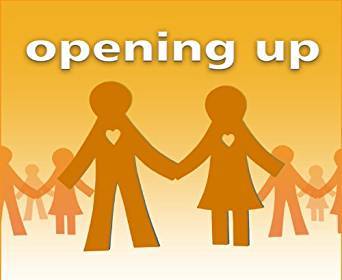
Ten years ago, a friend at work handed me a book by James Pennebaker: Opening Up — The Healing Power of Expressing Emotions (249 pages, 1997). This book influenced me a lot. It was 2007 and I was going through turmoil in my personal life. Pennebaker's book suggested a technique for feeling better: 'opening up' to somebody. After several months, in 2008, I consciously opened up to a good friend of mine, sharing with her random incidents from my life which had been bothering me. I had bared my soul to her, keeping nothing secret. That helped. Since then, 'opening up' has been #3 on my list of self-help techniques after meditation and physical fitness.
Opening up amounts to self disclosure. When we open up, we share our innermost feelings and thoughts related to those feelings with a confidant, without hiding anything. The listener must be non-judgmental, calm and peaceful; somebody who can keep secrets. Then healing takes place.
Talking: Being able to pour your heart out to a non-judgmental confidant is a blessing. Maybe it's a parent, a sibling, an uncle or an aunt, or a teacher, or a lover, or a friend. If no such person exists, one may meet a counselor via medical insurance, or find support groups where people take turns talking in a 'circle of sharing'. Even strangers like taxicab drivers and co-passengers in airplanes can play the role of being a non-judgmental listener.
Journaling: Pouring your heart out on a piece of paper (or in an email or in an online personal document) is another technique for opening up. James Pennebaker's Opening Up is mostly about journaling.
Confessions: In the West, certain relationships are protected in criminal proceedings. These relationships are with attorneys, priests, doctors (especially mental health professionals) and spouses. If we are mentally disturbed because we did something wrong, these relationships provide a safe environment for therapeutic conversations.
Art: Many people are able to express their thoughts and emotions via art, which is another form of opening up. Art Therapy is a structured approach for doing so.
Living The Truth by Keith Ablow (320 pages, 2008) explains the healing mechanism in psychotherapy. Basically, a series of sessions help establish a relationship of trust between a therapist and a patient. At some point of time, the therapist is able to take the patient back in time to recount traumatic events in the patient's life. During that session, the patient relives the emotions associated with that trauma and narrates them to the therapist. Such a session has monumental value; it's healing. For example, see this scene from the movie "Analyze This": "I Just Let Him Die!" (3 mins, YouTube).
Hypnotherapy works similarly. The only difference from psychotherapy is that the patient is hypnotized. Otherwise, the process is the same: the therapist is able to help the patient relive the traumatic moments from the past, thereby coming to terms with them.
The Grief Recovery Handbook (240 pages, 2017) describes a simple procedure for grief recovery. The first chapter lists various techniques that do not work. From the second chapter onward, the following technique is outlined:
- Find another person who is in grief and who would like to apply this technique. The two of you will agree to meet at an appointed time and talk.
- Prepare for the meeting by making a timeline of losses that you have experienced in the past. Also note down their relative intensity. This step is important because many times, memories of an old unresolved loss come to the surface when we are coping with a newly occurred loss. Next, write down both positive and negative thoughts and emotions associated with the loss. If an old loss is surfacing, this exercise has to be done with respect to the old loss as well.
- When the two of you meet, both of you take a vow of secrecy, that whatever information gets exchanged in the meeting will go with you to your grave.
- Finally, take turns to go through the points listed in your write-ups. Take your time to narrate the positive and negative thoughts and emotions associated with the loss. It is important the listener be non-judgmental and just be.
Since 2007, I have attended 10-day Buddhist meditation retreats which have helped me significantly. A chance remark by a friend helped me realize that the meditation technique taught at these retreats is actually a 1-person technique for opening up! I was fascinated to see meditation that way :) Let me explain.
The first technique taught in the 10-day meditation retreats is Breath Meditation: we learn to pay attention to unmodified breath in the nose region for long periods of time, without getting distracted. This practice develops 'awareness' (we become adept at paying attention to subtle bodily phenomena like breath and body sensations). It also develops 'one-pointedness' (we don't get distracted easily) and 'tranquility' (we become calm).
After practicing Breath Meditation for a few days, we are taught taught Insight Meditation (also known as 'Vipassana Meditation'). In this practice, we scan our body from head to toe, slowly, focusing on sensations that arise on the surface of the body (the body scan techniques are quite detailed and intricate; only a good teacher can describe them well). With each sensation that we encounter, we make sure that we don't react with craving or aversion. Some sensations are unpleasant which trigger a response full of aversion. Sometimes, we miss pleasant sensations that we experienced in the past and we trigger craving for them. The key ingredient of Insight Mediation is to stay away from both craving and aversion. This way, we become 'equanimous' (balanced, even, level).
At the meditation retreat, we are encouraged to notice within ourselves that our mind works sequentially as follows:
- Cognition: we see something, we hear something, we smell something, we feel something, we taste something or we think something; so it's the five senses and the thought process).
- Recognition: we remember that what we just cognized has happened in the past.
- Sensation: after recognition, a sensation arises somewhere in the body (not limited to the surface of the body but anywhere).
- Reaction: this is our response to the sensation.
At the meditation retreat, we are taught that we can't influence the first three steps (cognition, recognition and sensations). However, we can train our mind to react differently from how we have been reacting in the past to similar sensations. That's the key to healing. We are encouraged to notice that our misery (negative feelings characterized by anger, hatred, ill-will, fear and so on) is a function of our reaction, nothing else: if we react with craving for a pleasant sensation that is no longer available, or if we react with aversion to an unpleasant sensation that is occurring right now, we become miserable. On the other hand, if we react with equanimity (characterized by positive emotions like joy, love, kindness and so on), we are calm and peaceful.
When we start meditating (Breath Meditation or Insight Meditation), thoughts associated with some trauma from the past become strong. Quickly, we start feeling unpleasant sensations in our body. Thoughts and sensations associated with that trauma start manifesting themselves like an avalanche. We try our best to practice equanimity, thereby changing our reaction to these sensations. In some sense, we relive the past, just like in a psychotherapy session, or a hypnotherapy session, or when we were journaling or talking to a confidant.
Thus the overall process of healing through meditation is the same as opening up. However, it is a 1-person system in which we play the roles of both the narrator and the listener :)

